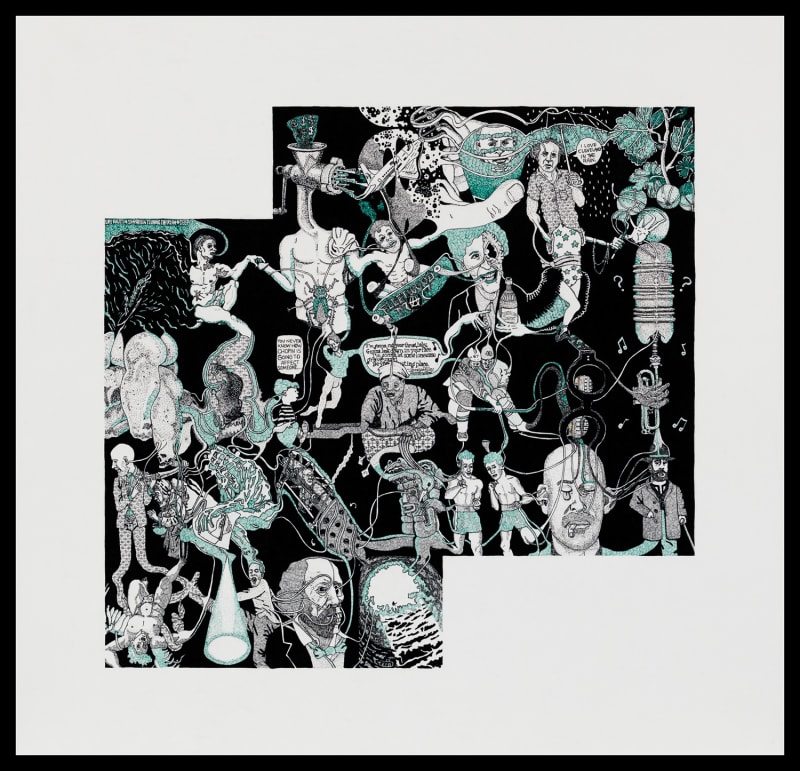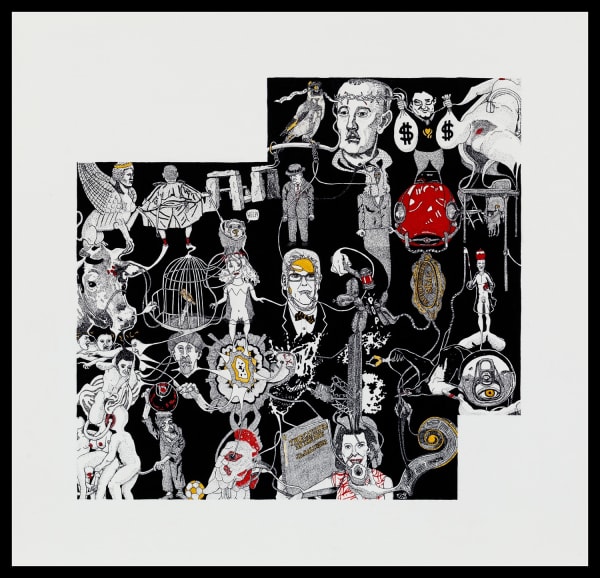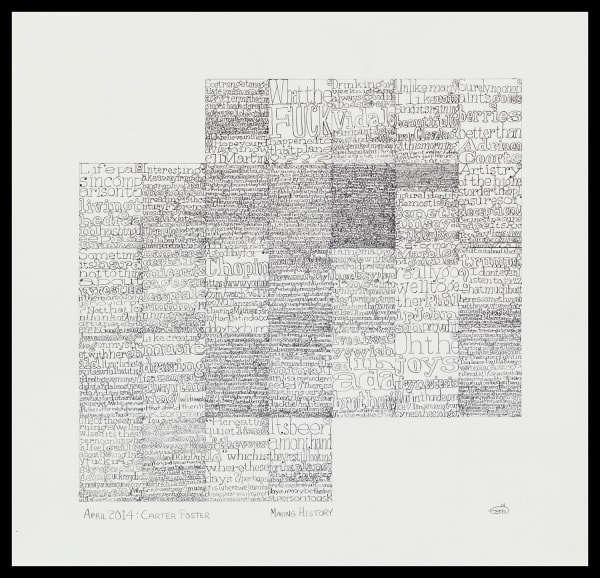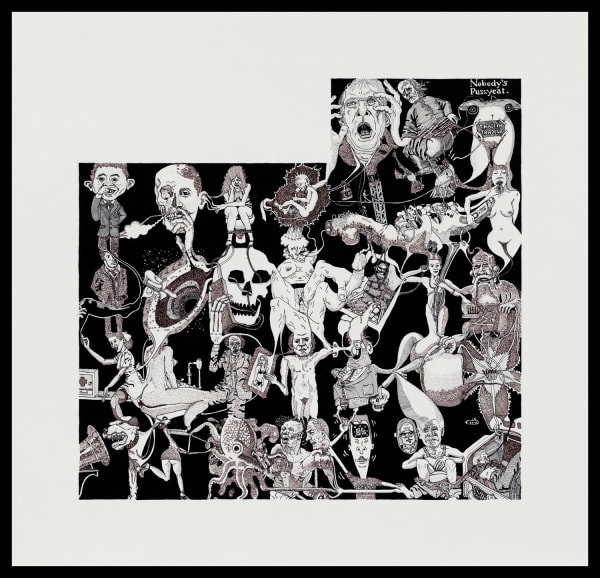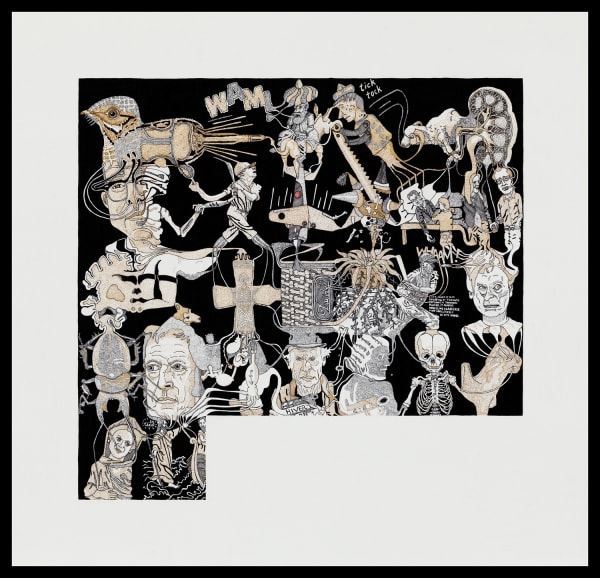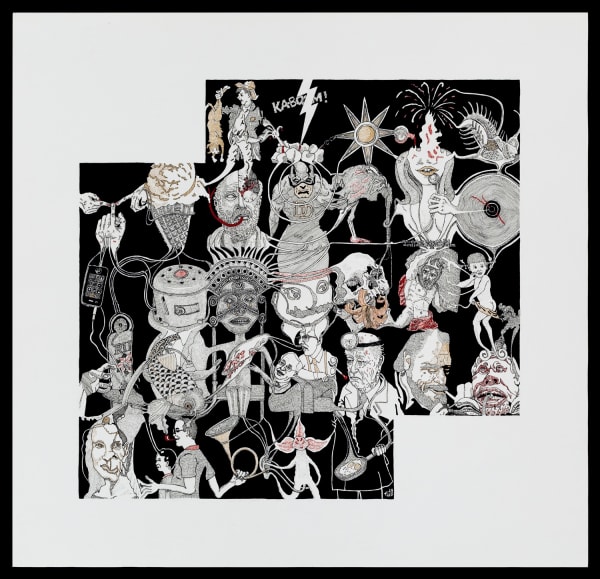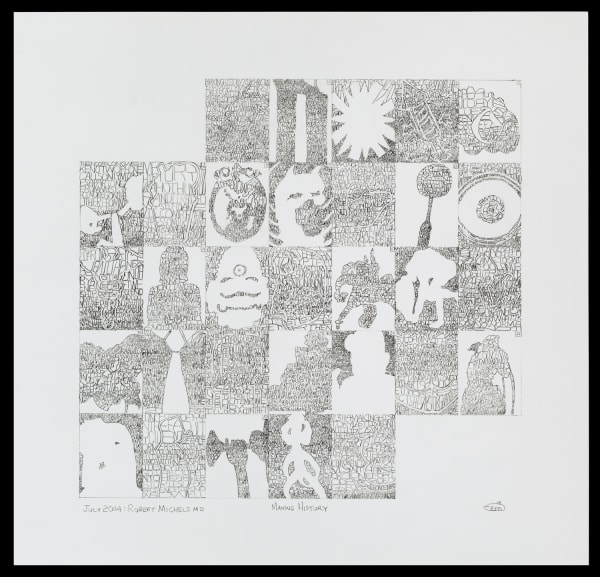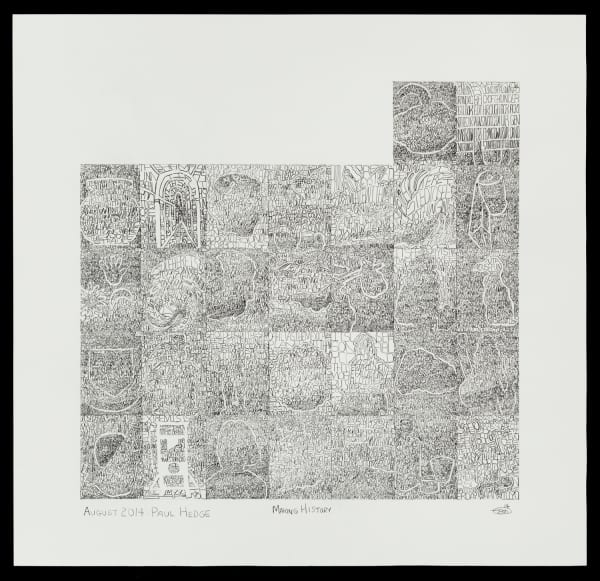Martin Wilner: Making History: The Case Histories 2014
Hales Gallery is pleased to announce an exhibition of pen, ink, and graphite works on paper by Martin Wilner. This is his second one-person exhibition with the gallery. Wilner is also an Assistant Clinical Professor of Psychiatry at Weill Cornell Medical College. A unifying theme in both of his professional realms is the use of observation–in art, for the creation of his work, and in clinical practice, as a means to facilitate dynamic change and conflict resolution in individuals seeking consultation.
Making History is a time-based project initiated in January of 2002 that utilises the convention of the Roman calendar to telegraph the notion of the passage of time over the course of each month. Wilner selects a daily subject of interest to him from a variety of media sources and visualises them each day as a drawing that would coalesce into a completed work by the end of each month. Elements of cartoon, cartography, text, micrography, and music have evolved into essential aspects of his creative vocabulary. On the verso of each drawing are descriptive texts or images that are integral to the work.
Upon completion of a decade of this project in 2012, Wilner elected to push the creative envelope of this parameter-based body of work by inviting individuals familiar with his work to correspond with him daily for a month-long period and send him messages describing what they found of compelling interest to them on each day of their assigned month. He would then visualise each correspondence daily to produce the composite work by month's end.
Aside from the exciting new challenges posed to his drawing practice, it introduced a relational situation of a defined intensive nature that has become the basis of this work. As such, the work has shifted from a subjective visual history into an unusual form of biographical portraiture over a discrete time period, a portrait of a state of mind in time. The process of producing each work, in addition to the conventions and rigours of drawing, thus entails an examination of the correspondence not simply by its manifest content, but also a consideration of latent meanings and relationships between the thoughts over the course of a period of time. Fundamental psychoanalytic principles must be applied to the task of processing the correspondence, including resistances, transference and countertransference. The drawing itself becomes an attempt to address and resolve these matters in a sublimated visual form for the purpose of art rather than therapeutic intervention. The monthly works are, in effect, case studies of a most unusual nature.
Dr. Robert Michels, one of the most prominent contemporary psychoanalysts and the subject of July 2014, described it well in his first correspondence to Wilner: “… My first observation is my awareness of the effect of knowing that I will be reporting to you–I am aware of seeking perceptions and experiences, and as a result the world seems different.”
In an effort to address Freud’s unanswered, politically incorrect famous question, “What does a woman want?”, Wilner selected an array of women as subjects for his 2013 Case Studies. He thought it only appropriate to follow that up with a year of men to address the corollary question, “What does a man want?" The subjects ranged from a 9-year-old Mensa scholar to art curators, artists of different disciplines, art collectors, an antiquarian manuscript dealer, to a 92-year old venerated art gallerist.
For 2014, Wilner introduced the use of colour into what were, until now, black and white works, feeling that the work was ready for the introduction of this new parameter. The works range from subtle trichomal approaches to unusual blendings of watercolor-based inks. This latest development brings an additional dimension of richness to these already highly complex works.
Also presented are recent works from Wilner’s other ongoing project, Journal of Evidence Weekly, an observational in vivo documentation of every trip he has made on the subways of New York since 1998. It is the improvisational jazz that informs the more classically composed Making History.
Martin Wilner was born in 1959 and resides in New York City. His work has been exhibited widely and is in numerous important private and institutional collections including the Whitney Museum of American Art, the Los Angeles County Museum of Art, the Jewish Museum, and the Vassar Art Library. His work is currently on view at the Morgan Library and Museum in “Embracing Modernism: Ten Years of Drawing Acquisitions”.
Wilner has been selected as Artist in Residence at SETI (Search for Extraterrestrial Intelligence) for 2015/16. He was interviewed in the Winter 2014/2015 edition of BOMB magazine number 130. In January 2015 he was invited to deliver a Grand Rounds address to the department of Psychiatry at Weill Cornell Medical College on “The Case Histories: A Peculiar Application of Psychoanalytic Theory in My Art Practice”. The Drawing Center in New York City will be releasing a limited artist’s edition of Case Histories 2012 in conjunction with an artist’s talk with executive director Brett Littman. In addition, his most recent Game Pieces project, The Singles, will appear in the upcoming Esopus 22: Medicine.
-

Making History: Case Histories
January 2014: Alexander Adler, 2014
pen and ink on Bristol board
41.9 x 43.5 cm
16 1/2 x 17 1/8 in -

Making History: Case Histories
January 2014: Alexander Adler (verso), 2014
graphite on Bristol board
41.9 x 43.5 cm
16 1/2 x 17 1/8 in -

Making History: Case Histories
February 2014: Dr Jorn Gunther, 2014
pen and ink on Bristol board
41.9 x 43.5 cm
16 1/2 x 17 1/8 in -

Making History: Case Histories
February 2014: Dr Jorn Gunther (verso), 2014
graphite on Bristol board
41.9 x 43.5 cm
16 1/2 x 17 1/8 in -

Making History: Case Histories
March 2014: Philip Aarons, 2014
pen and ink on Bristol board
41.9 x 43.5 cm
16 1/2 x 17 1/8 in -

Making History: Case Histories
March 2014: Philip Aarons (verso), 2014
graphite on Bristol board
41.9 x 43.5 cm
16 1/2 x 17 1/8 in -

Making History: Case Histories
April 2014: Carter Foster, 2014
pen and ink on Bristol board
41.9 x 43.5 cm
16 1/2 x 17 1/8 in -

Making History: Case Histories
April 2014: Carter Foster (verso), 2014
graphite on Bristol board
41.9 x 43.5 cm
16 1/2 x 17 1/8 in -

Making History: Case Histories
May 2014: Francis Levy, 2014
pen and ink on Bristol board
41.9 x 43.5 cm
16 1/2 x 17 1/8 in -

Making History: Case Histories
May 2014: Francis Levy (verso), 2014
graphite on Bristol board
41.9 x 43.5 cm
16 1/2 x 17 1/8 in -

Making History: Case Histories
June 2014: Roy Davis, 2014
ink on Bristol Board
41.9 x 43.5 cm
16 1/2 x 17 1/8 in -

Making History: Case Histories
June 2014: Roy Davis (verso), 2014
graphite on Bristol Board
41.9 x 43.5 cm
16 1/2 x 17 1/8 in -

Making History: Case Histories
July 2014: Dr Robert Michels, 2014
pen and ink on Bristol board
41.9 x 43.5 cm
16 1/2 x 17 1/8 in -

Making History: Case Histories
July 2014: Dr Robert Michels (verso), 2014
graphite on Bristol board
41.9 x 43.5 cm
16 1/2 x 17 1/8 in -

Making History: Case Histories
August 2014: Paul Hedge, 2014
pen and ink on Bristol board
41.9 x 43.5 cm
16 1/2 x 17 1/8 in -

Making History: Case Histories
August 2014: Paul Hedge (verso), 2014
graphite on Bristol board
41.9 x 43.5 cm
16 1/2 x 17 1/8 in -

Making History: Case Histories
September 2014: Elias Herder, 2014
pen and ink on Bristol board
41.9 x 43.5 cm
16 1/2 x 17 1/8 in -

Making History: Case Histories
September 2014: Elias Herder (verso), 2014
graphite on Bristol board
41.9 x 43.5 cm
16 1/2 x 17 1/8 in -

Making History: Case Histories
October 2014: Marco Breuer, 2014
pen and ink on Bristol board
41.9 x 43.5 cm
16 1/2 x 17 1/8 in -

Making History: Case Histories
October 2014: Marco Breuer (verso), 2014
graphite on Bristol board
41.9 x 43.5 cm
16 1/2 x 17 1/8 in -

Making History: Case Histories
November 2014: Charles Lindsay, 2014
pen and ink on Bristol board
41.9 x 43.5 cm
16 1/2 x 17 1/8 in -

Making History: Case Histories
November 2014: Charles Lindsay (verso), 2014
graphite on Bristol board
41.9 x 43.5 cm
16 1/2 x 17 1/8 in -

Making History: Case Histories
December 2014: Brett Littman, 2014
pen and ink on Bristol board
41.9 x 43.5 cm
16 1/2 x 17 1/8 in -

Making History: Case Histories
December 2014: Brett Littman, 2014
graphite on Bristol board
41.9 x 43.5 cm
16 1/2 x 17 1/8 in -

Journal of Evidence Weekly Volume 164 (detail)
ink on paper (bound accordion book, framed)
231 x 26 cm
91 x 10 1/4 in -

Journal of Evidence Weekly Volume 165 (detail)
ink on paper (bound accordion book, framed)
231 x 26 cm
91 x 10 1/4 in
